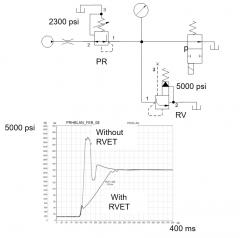In this example, a vented anti-shock relief valve RV*T is used in a bypass leg of a pressure reducing valve. Port 3 of the RV*T is plugged. In the set up for the test, the 2/2-way directional valve represents a cylinder that either moves freely or stops. In the example, a direct-acting PR*B controls the pressure. The RV*T controls the rate of pressure rise only and not the final controlled pressure level.
- Direct-acting pressure control: PR*B
- Pilot-operated pressure control: PP*B
- Vented anti-shock relief: RV*T
Benefits of this circuit arrangement:
- The additional RV*T improves the dynamic pressure control with PR* or PP* valves. The controlled pressure shows no overshoot when the flow to the motor stops, a cylinder stops against a load or when it is fully extended.
- The additional RV*T also avoids pressure spikes when the upstream supply changes - for example, when the directional valve is activated. The setting of the pressure control valve (2300 psi) is below the setting of the anti-shock relief valve.



